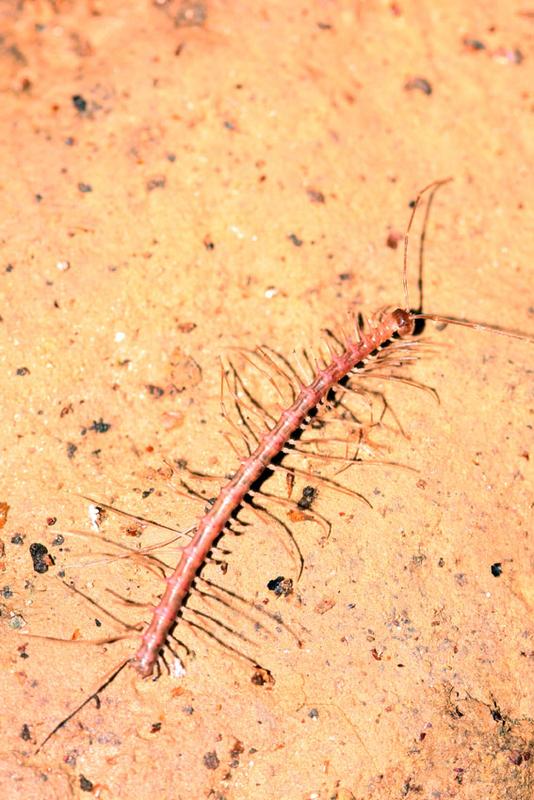Dragons out of the dark: New species of Dragon Millipedes discovered in Chinese caves

The extremely long legs of the Stick Insect Dragon Millipede, Desmoxytes phasmoides give the animal an unusual appearance, similar to a stick insect. Sunbin Huang & Xinhui Wang (South China Agricultural University)
In many tropical countries, there are numerous millipede species still awaiting discovery and description. Millipedes from China are especially little-known. Six particularly unusual species of so-called 'Dragon Millipedes', four of which found exclusively in caves, were recently discovered in southern China by an international team of researchers.
The team included Miss Liu Weixin from the South China Agricultural University of Guangzhou, China [LINK1], currently conducting research for her PhD focusing on Chinese cave millipedes at the Centre of Taxonomy at the Research Museum Koenig (ZFMK), Leibniz Institute for Animal Biodiversity in Bonn, Germany [LINK2], her advisor Prof. Tian Mingyi [LINK3] and a renowned millipede expert, Dr. Sergei Golovatch, from the Russian Academy of Sciences, Moscow.
Dragon Millipedes, a genus of millipedes living in SE Asia, characterized by being armoured with unusual spine-like projections as well as toxic hydrogen cyanide, have become particularly famous since the 2007 discovery and description of the “Shocking Pink Dragon Millipede” in Thailand [LINK4].
This discovery highlighted a large number of unknown millipede species [LINK4] in the Mekong region [LINK5] and worldwide [LINK6]. While the newly described cave Dragon Millipedes from China lack the 'shocking' warning colour of their surface-living relatives, they are no less spectacular.
One of the species was named the 'Stick Insect Dragon Millipede' because it features extremely long legs and antennae, and resembles a stick insect, but with many more legs (Fig. 2). Two of the other species from caves fully lost their colour, which is a common characteristic of cave-living animals.
Because of this, they appear ghostly white (Fig. 3). All the newly described species come from the two southern Chinese regions of Guangdong and Guangxi Zhuang, which host a large number of spectacular caves (Fig. 1). These caves are only now being explored in some detail.
In the course of her PhD, Miss Liu Weixin has already explored more than 200 Chinese caves (Fig. 1) and discovered and described over 20 new millipede species. The Dragon Millipedes are among her most spectacular discoveries as they exhibit extreme cave adaptations including the loss of pigmentation and extremely elongated legs and antennae. During her guest research year at the Research Museum Koenig in Bonn, Germany, Liu is currently busy describing more than two dozen further millipede species, which she collected from Chinese caves – literally bringing to light an unknown world.
Link1 https://www.zfmk.de/en/zfmk/weixin-liu
Link2 https://www.zfmk.de/en
Link3 http://xy.scau.edu.cn/nxy/cx/Ch/xrjsview.asp?ID=305&SortID=167
Link4 http://www.bbc.com/earth/story/20150320-meet-two-new-dragon-millipede-species-fi…
Link5 http://news.nationalgeographic.com/news/2008/12/photogalleries/greater-mekong-ne…
Link6 http://www.biotec.or.th/en/index.php/news-2008/755-thailand-s-shocking-pink-drag…
Contact person(s): Sergei Golovatch [English], 7(499)936-7671,
sgolovatch@yandex.ru; Thomas Wesener [German], 0049 (0)228 9122-425, t.wesener@zfmk.de
Publication: Six new species of dragon millipedes, genus Desmoxytes Chamberlin, 1923, mostly from caves in China (Diplopoda, Polydesmida, Paradoxosomatidae). Weixin Liu, Sergei Golovatch, Mingyi Tian
ZooKeys 577: 1-24 (05 Apr 2016)
doi: 10.3897/zookeys.577.7825
Zoological Research Museum Alexander Koenig – Leibniz-Institute for Animal Biodiversity (ZFMK) is an independent research institute. The focus of research is on performing an inventory of the zoological species diversity on earth, on the analysis of changes in biodiversity as a result of environmental factors, and on evolutionary processes at the morphological and molecular levels. ZFMK furthermore explores the context of structure and function of ecological systems, advanced scientific methods, and the study of the history of science. The permanent exhibition “Our blue planet – the living network” offers a genuine nature experience based on naturalistic ecosystem displays.
The Leibniz Association is a network of 89 scientifically, legally, and economically independent research institutes and scientific service facilities. Leibniz Institutes perform strategic and thematically-oriented research and offer scientific service of national significance while striving to find scientific solutions for major social challenges.
Media Contact
All latest news from the category: Earth Sciences
Earth Sciences (also referred to as Geosciences), which deals with basic issues surrounding our planet, plays a vital role in the area of energy and raw materials supply.
Earth Sciences comprises subjects such as geology, geography, geological informatics, paleontology, mineralogy, petrography, crystallography, geophysics, geodesy, glaciology, cartography, photogrammetry, meteorology and seismology, early-warning systems, earthquake research and polar research.
Newest articles

A ‘language’ for ML models to predict nanopore properties
A large number of 2D materials like graphene can have nanopores – small holes formed by missing atoms through which foreign substances can pass. The properties of these nanopores dictate many…

Clinically validated, wearable ultrasound patch
… for continuous blood pressure monitoring. A team of researchers at the University of California San Diego has developed a new and improved wearable ultrasound patch for continuous and noninvasive…

A new puzzle piece for string theory research
Dr. Ksenia Fedosova from the Cluster of Excellence Mathematics Münster, along with an international research team, has proven a conjecture in string theory that physicists had proposed regarding certain equations….



